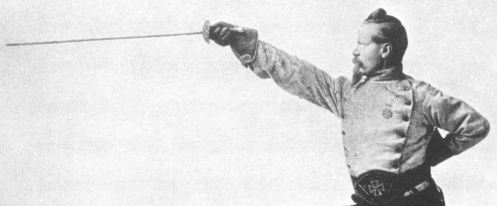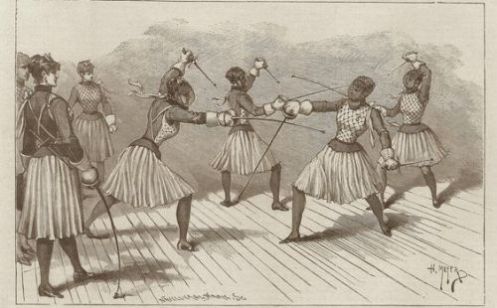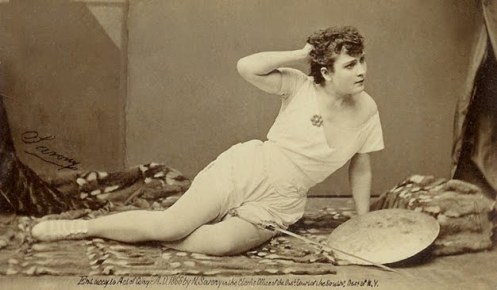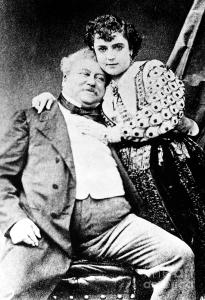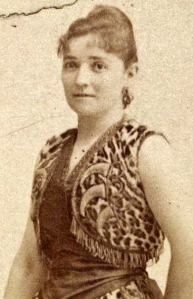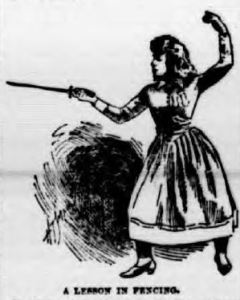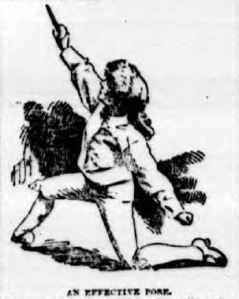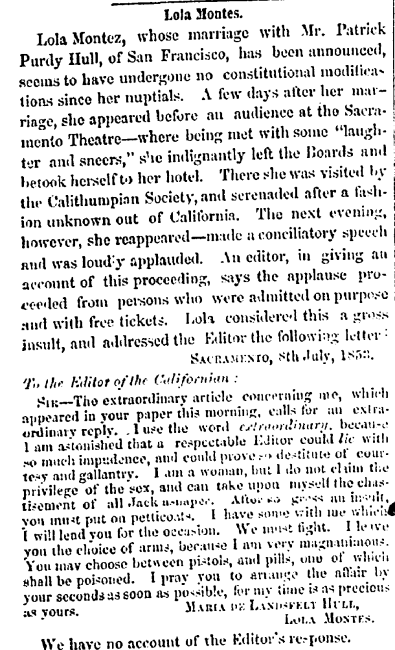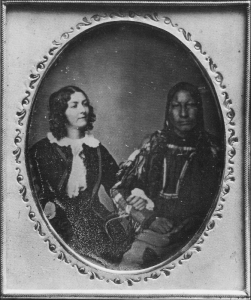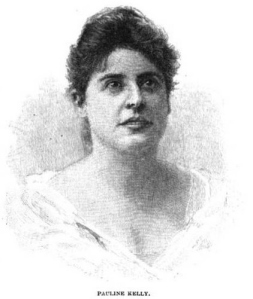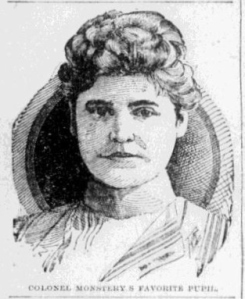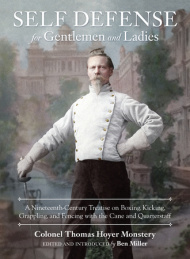Colonel Thomas Monstery, and the Training of America’s Swordswomen
“It is a great mistake to suppose that women cannot learn fencing as quickly as men…the fact is the women are much the quicker pupils. They are more flexible of body; their limbs are more supple and elastic—that’s one advantage. Their mental brightness enables them to pick up the strategy of the art quicker—that’s a second advantage. And, thirdly, they have more nerve—it’s a fact; I don’t know why, but it’s a fact.” – Col. Thomas Monstery, 1888
Continued from Part I.
By Ben Miller
In 1870, one of America’s most distinguished martial arts masters opened a “School of Arms” in New York City. He was a fencing master, boxer, marksman, sailor, adventurer, street fighter, soldier of fortune, and world traveler. He was Colonel Thomas Hoyer Monstery.
When it came to combat, Monstery had an impressive resume. He had fought under twelve flags in numerous wars and revolutions, had survived participation in more than fifty duels with the sword, knife, and pistol, and had twenty-two scars on his body to prove it. In addition to being a “master of all arms” (which included the rapier, dagger, broadsword, Bowie knife, lance, bayonet, and quarterstaff, among others), Monstery was also a “professor of sparring,” and taught a special system of bare-knuckle self-defense that integrated punching, grappling, and kicking techniques, designed to be effective against a wide range of fighting styles.
One of Monstery’s most unusual traits, however, was that he encouraged women to take up fencing with a variety of weapons, as well as boxing, long before it was both popular and fashionable for them to do so. Monstery claimed that he taught his female pupils no differently than he did men. This was a great point of distinction; typically, the scarce fencing instruction available to women during this period was limited to the use of the foil, an academic training tool. Monstery, however, did not limit his instruction to the art of the sword; in 1888, he was teaching “two classes of lady-boxers”; in New York City, he also held several ladies’ classes in stick self-defense. Evidence also suggests that to select female students, he also provided instruction in the rapier, dagger, knife, and bayonet. Additionally, Monstery included a special drill in his curriculum intended to prepare his female pupils for potential street encounters, teaching them to deliver a “bayonet thrust” with their parasols, which, he said, “would break a rib, or a one-handed thrust, that would put out an eye.”
Perhaps due to this progressive attitude, Monstery was able to attract a remarkable number of high-profile female students, some of whom led truly extraordinary lives. Following are their stories.
Ada Isaacs Menken (1835-1868)
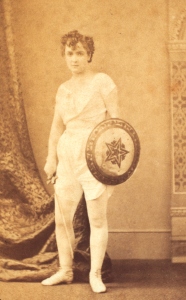 On the right, Ada Isaacs Menken poses with sword and shield for her role in the melodrama “Mazeppa.” According to the Daily Inter Ocean of Oct. 29, 1893, Colonel Monstery personally prepared Menken for this role; although she had only intended to learn fencing for this specific production, she afterwards became a regular student of Monstery’s.
On the right, Ada Isaacs Menken poses with sword and shield for her role in the melodrama “Mazeppa.” According to the Daily Inter Ocean of Oct. 29, 1893, Colonel Monstery personally prepared Menken for this role; although she had only intended to learn fencing for this specific production, she afterwards became a regular student of Monstery’s.
Menken was the highest earning actress of her time, all the more impressive considering that she had to overcome the society-imposed stigma of mix-raced ancestry. Her parents were Auguste Théodore, a free black, and Marie, a mixed-race Creole, and Ada was raised in the New Orleans area as a Catholic. Ed James, a journalist friend, wrote after her death: “Her real name was Adelaide McCord, and she was born at Milneburg, near New Orleans, on June 15, 1835.”
Menken became best known for her performance in Mazeppa, with a climax that featured her apparently nude and riding a horse (lying on her back face-up) on stage. She was also an accomplished writer and poet, and became close friends with Walt Whitman, Charles Dickens, and William Makepiece Thackeray. For a short time, she was married John C. Heenan, the famous pugilist. During her stay in Paris, she engaged in a “scandalous” affair with the French novelist Alexandre Dumas, famous author of the “Three Musketeers” and “The Count of Monte Cristo.”
She died in the Jewish faith in Paris on August 10, 1868. On her deathbed, she talked of this world and the next with a rabbi she had befriended, and then wrote, “I am lost to art and life. Yet, when all is said and done, have I not at my age tasted more of life than most women who live to be a hundred? It is fair, then, that I should go where old people go.” She was buried in Montparnasse cemetery. On her tomb, at her request, were engraved the words ‘Thou Knowest’.
More about Menken’s amazing life and career can be read about here and here.
Marie Jansen (1857-1914)
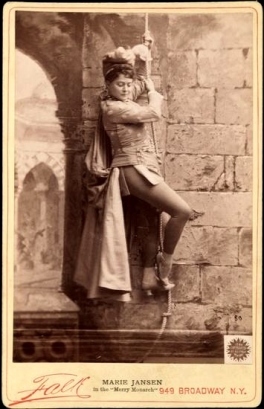 Marie Jansen, another fencing student of Colonel Monstery’s, is pictured here scaling a castle wall for her role in “The Merry Monarch.” The New York Herald of February 1, 1891, reported that “Marie Jansen lost ten pounds in three weeks under Colonel Monstery.” In an 1888 issue of the Daily Inter Ocean, Monstery recounted: “Marie Jansen was a pupil of mine. She was quite an expert fencer, but grace of movement is her forte. She moved like a—ah, what shall I say?—a swan. Her pose, her graceful methods of parry and of thrust are enough to enchant an antagonist.”
Marie Jansen, another fencing student of Colonel Monstery’s, is pictured here scaling a castle wall for her role in “The Merry Monarch.” The New York Herald of February 1, 1891, reported that “Marie Jansen lost ten pounds in three weeks under Colonel Monstery.” In an 1888 issue of the Daily Inter Ocean, Monstery recounted: “Marie Jansen was a pupil of mine. She was quite an expert fencer, but grace of movement is her forte. She moved like a—ah, what shall I say?—a swan. Her pose, her graceful methods of parry and of thrust are enough to enchant an antagonist.”
Jansen was born in Boston in 1857. She would go on to star in a number of successful comic operas, Edwardian musical comedies, and comic plays in New York, Boston, Philadelphia and London during the 1880s and 1890s. Later in her career, she performed in vaudeville and formed her own touring theatre company.
More about Jansen’s life can be read about here.
Ella “Jaguarina” Hattan (b. 1859)
Ella Hattan, better known by her nom-de-guerre “Jaguarina,” was Colonel Thomas Monstery’s most accomplished student. Born in 1859 in Ohio, she would go on to become widely regarded as one of the greatest swordswomen of the nineteenth century, and perhaps of all time.
When Monstery presented Hattan to the world in early 1885, he “pronounced her the equal of any swordsman in America barring none, she seemingly having a wrist of steel and muscles of iron under a velvet skin.” This statement would prove prophetic, as Hattan would go on to defeat more than 60 men (half of them fencing masters) on horseback and on foot. Decades later, Hattan recounted that her training under Monstery was harsh—so much so that in three years her teacher “had never given her one word of encouragement,” he being “determined that she should learn confidence by experience and hard knocks.” Yet Hattan was also quick to give Monstery credit for his abilities. Prior to her contest with Sergeant Owen Davis, in an 1887 interview, she stated that “with the exception of Colonel Monstery, Sergeant Davis and Captain Jennings were probably the best [swords]men she had met.” Years later, in 1896, Monstery would return the compliment, reportedly averring that “Jaguarina is undoubtedly the greatest woman fencer that ever lived.”
For more details of Hattan’s extraordinary career, her training, and her lengthy master-student relationship with Monstery, see this article.
Mildred Holland (1869-1944)
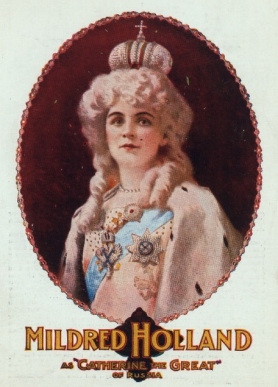 Mildred Holland is pictured here in her 1904 role as Catherine the Great. Next to Ella Hattan, Holland was one of Monstery’s best known students and a “champion” of many fencing contests.
Mildred Holland is pictured here in her 1904 role as Catherine the Great. Next to Ella Hattan, Holland was one of Monstery’s best known students and a “champion” of many fencing contests.
In the Dec. 9, 1888 issue of the Inter Ocean,
“Colonel [Monstery]…confesses that [Holland] is often a match for his superior skill. ‘Can ladies fence! Well, did you not see Miss Mildred kill me then? Ladies, when trained, are perfect artists with the foils.’”
Mildred Holland would later become a respected fencing instructor in her own right. In 1895 she presided over exhibitions of rapier and dagger in New York City, and delivered lectures on “the Art of Defense” for women, “Referring Especially to Umbrellas in the Hands of Experts.”
During the 1890s, Holland held bouts of rapier and dagger fencing in New York City, and lectured on women’s self defense. Following is an excerpt from a period article, with images, about Holland’s training under Monstery, published in the New York World on June 22, 1890:
“Miss Holland is not a social star, but a hard-working student. Self-reliance, grit and confidence in her own capabilities are elements which have sustained the little lady in her ambition. She is not rich, and her tuition was secured by her well-saved earnings. Her pluck has been demonstrated by her wonderful dexterity with the foils.
“In this accomplishment she is a pupil of Col. Monstery, is accounted one of the most expert swordswomen in the United States and is the possessor of two gold medals for efficiency, one of which was won two years ago at a contest and presented to the fair champion by Lieut. Gov. Smith. Holland makes a series of rapid, graceful attitudes. The little white wrist is as firm and flexible as steel, the ankle well turned and solid, and the head gracefully poised, She is quick in her motions, exhibiting litheness, grace and precision. Her recoveries are rapid, her eye true, and she enters into her work with striking coolness and nerve. Col. Monstery says she is a wonder and the Conservatory is proud of its champion, for, in addition to her trophies, she defeated by six points Miss Anna Schaffer, one of the professional Viennese swordswoman. Miss Holland is modest of her achievements.
“‘I began fencing when I entered the Conservatory,’ said she. ‘It is part of the instruction. Its object is to train the muscles of the entire body, to develop flexibility and to give one a facility of poses that cannot otherwise be attained. Then you know it strengthens the lungs, trains the eyes, and, I think, cultivates one’s courage. You know it takes courage to appear properly before an audience, and I am sure my ‘faculty’ of courage has developed since I began fencing.'”
Lola Montez (1821–1861)
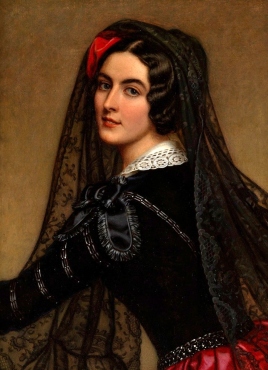 “Lola Montez,” in actuality Marie Dolores Eliza Rosanna Gilbert, Countess of Landsfeld, was an Irish dancer and actress (born in Limerick) who became famous as a “Spanish dancer,” courtesan, and actress. After performing in various European capitals, she settled in Paris, where she was accepted in the rather Bohemian literary society of the time. After the 1845 death of her lover, newspaperman Alexandre Dujarier, in a duel (unrelated to her), she left Paris, and became mistress of King Ludwig I of Bavaria, who made her Countess of Landsfeld. She used her influence to institute liberal reforms in Germany. At the start of the Revolutions of 1848 in the German states, she was forced to flee. She proceeded to the United States via Switzerland, France and London, returning to her work as an entertainer and lecturer.
“Lola Montez,” in actuality Marie Dolores Eliza Rosanna Gilbert, Countess of Landsfeld, was an Irish dancer and actress (born in Limerick) who became famous as a “Spanish dancer,” courtesan, and actress. After performing in various European capitals, she settled in Paris, where she was accepted in the rather Bohemian literary society of the time. After the 1845 death of her lover, newspaperman Alexandre Dujarier, in a duel (unrelated to her), she left Paris, and became mistress of King Ludwig I of Bavaria, who made her Countess of Landsfeld. She used her influence to institute liberal reforms in Germany. At the start of the Revolutions of 1848 in the German states, she was forced to flee. She proceeded to the United States via Switzerland, France and London, returning to her work as an entertainer and lecturer.
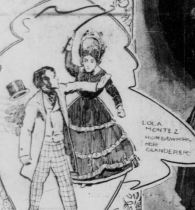 The Trenton Evening Times reported that:
The Trenton Evening Times reported that:
“Lola Montez was skillful with both pistol and rapier…She once challenged a journalist at Grass Valley, California, to meet her with pistols according to prevailing rules governing such meetings, and, upon his refusal to do so thrashed him with a cowhide upon a public street.”
The article pictured here, with Lola’s challenge to duel in California, was published in the Richmond Whig of August 16, 1853.
Montez challenged at least two men to duels with poison pills, and at least one with the pistol (see picture). Another of her challenges (to an insulting French editor of the Lyons Constitutionnel, in 1851) reads:
“If you continue, sir, I will be obliged to send you my card, and my seconds, to put an end to your ridiculous animosity; but it will not be with pistols; I am more generous in a combat. I will offer you two pills in a box, one of them will be poisoned; and you will not be able to refuse a duel with arms that are so familiar to you. I have the honor of saluting you.”
In 1860, it was reported, erroniously, that Lola was killed in a duel at San Juan de Niblo.
Montez seems to have become a student of Monstery’s rather late in her life, which was cut tragically short by a stroke in 1861. In the November 30, 1886 issue of the Daily Inter Ocean, Monstery recounted
“an incident of a combat between the elder [Junius] Booth, who was the champion amateur swordsman of his time and himself, on an occasion of [Monstery’s] benefit in San Francisco a number of years ago. While the fight was on Lola Montez, who was one of the Colonel’s pupils, occupied a conspicuous box. During the bout she became so interested that she arose in her place, utterly forgetting where she was, and went through the movements as though actually one of the combatants on the stage. Of course her carrying on the imaginary combat attracted the notice of the house, which with divided attention cheered alternately the excited Lola and the two on stage.”
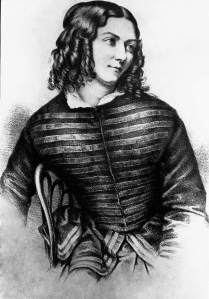 In America, Montez eventually gave up acting and gave lectures on “Gallantry, Heroines of History and other subjects.” She was highly critical of the “Modern Women’s Right Movement.” Montez felt that rather than lobbying men to give them more rights, women should endeavor to become strong and powerful themselves. Following are but a sampling of her statements:
In America, Montez eventually gave up acting and gave lectures on “Gallantry, Heroines of History and other subjects.” She was highly critical of the “Modern Women’s Right Movement.” Montez felt that rather than lobbying men to give them more rights, women should endeavor to become strong and powerful themselves. Following are but a sampling of her statements:
“One or two hundred women getting together in a convention and resolving that they are an abused community, and that all the men are great tyrants and rascals, proves plainly enough that they the women are somehow discontented, and that they have, perhaps, a certain amount of courage, but I can not see that it proves them to have any remarkable strength of mind. Really strong-minded women are not women of words but of deeds, not of resolutions but of actions.”
“History is full of such examples, which indicate the courage and intellect of woman, and her right to claim equality with the harder sex whenever Heaven has imparted to her the gift of genius. I can hardly see how it is possible that any woman of true genius should ever feel the necessity of calling together conventions for the purpose of resolving that she is abused. One woman going forth in the independence and power of self-reliant strength to assert her own individuality, and to defend, with whatever means God has given her, her right to a just portion of the earth’s privileges, will do more than a million of convention-women to make herself known and felt in the world.”
“There is a class of heroines who have been more powerful in the world than the mighty women of the sword or of the pen. I mean those who have united great personal beauty with rare intellectual powers! In such women there is a power stronger than strength. The annals of Greece and Rome, from the memorable days of Troy, down to the Roman age, furnish nothing more remarkable than the omnipotent sway of female genius and beauty in the affairs of the world.”
“The Amazons were regular woman’s rights women; for they made laws by which the women were enjoined to go to the wars, and the men were kept at home in a servile state, spinning wool and doing all manner of household work. No woman was allowed to marry till she had slain at least one enemy on the battle-field. The right breasts of all the female children were seared with a hot iron, in order to give the freest use of the right arm in wielding the sword or in shooting arrows; and they even debilitated the arms and thighs of the male children, that they might be rendered unfit for war. That, I should say, was carrying the woman’s rights question to an extent that ought to satisfy even our modern agitators. But in justice to these terrible Amazon women, it must be confessed that the world has never known better and braver warriors than they.”
With declining health, she finally moved to Brooklyn, New York, where she lived until her death. She spent her last days in rescue work among women.
More about Montez’s extraordinary life can be read about here.
Adele Belgarde (1867-1938)
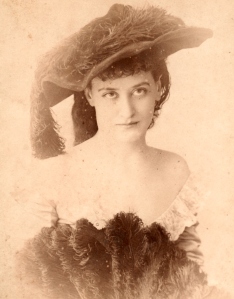 Born in Mississippi, Adele Belgarde (actual name Adelaide Levy) starred in a number of theatre productions in New York City during the late 1870s. She initially came to Monstery to learn fencing in order to prepare for her starring role in “Hamlet.” She would also star in “Romeo and Juliet” and would play Queen Elizabeth. In 1895-1896, Belgarde toured with Thomas W. Keene, the famous Shakespearean tragedian, playing Lady Anne to his Richard III. She also played Marie to his Louis XI. She would go on to star in at least one silent film titled “Happiness” in 1910.
Born in Mississippi, Adele Belgarde (actual name Adelaide Levy) starred in a number of theatre productions in New York City during the late 1870s. She initially came to Monstery to learn fencing in order to prepare for her starring role in “Hamlet.” She would also star in “Romeo and Juliet” and would play Queen Elizabeth. In 1895-1896, Belgarde toured with Thomas W. Keene, the famous Shakespearean tragedian, playing Lady Anne to his Richard III. She also played Marie to his Louis XI. She would go on to star in at least one silent film titled “Happiness” in 1910.
She died in 1938 and is buried in Forest Lawn Memorial Park, Glendale, Los Angeles County, California.
Maude Forrester
Maude Forrester was a lesser-known English actress who also, along with Ada Isaac Menkan, starred in “Mazeppa.” Under Monstery she became “quite proficient” in fencing. She was also billed as a “celebrated equestrian actress” who was known for her “matchless impersonation of Mazeppa! accompanied by [the] celebrated and highly trained steed, ‘Lightning’,” and was “universally recognised as Queen of the Amazons at the Alhambra before the advent of the colossal Marian of ‘the Praerafaellite maxillary angle’.” She also played the title role in Lady Godiva.
Pauline Kelly
Not much is known about Pauline Kelly. A number of references indicate that she was a pupil of Monstery’s while studying at Kayzer’s Conservatory in Chicago. She was “regarded in Chicago as a very promising and gifted young actress.” Monstery described her as an “expert fencer.”
Mabel Marsh
Miss Mabel Marsh learned fencing under Monstery at his Chicago salle d’armes on Randolph Street, where she often crossed blades with fellow actress and prodigy Mildred Holland. A detailed, firsthand account of Marsh’s training under Monstery can be found on pages 24-26 of the Introduction to “Self-Defense for Gentleman and Ladies” by Col. Thomas H. Monstery. These pages can be read in the free online preview of the book on its Amazon page.
Colonel Thomas H. Monstery‘s martial wisdom survives in his treatise on Boxing, Kicking, Grappling, and Fencing with the Cane and Quarterstaff, which was recently published by North Atlantic Books in book form for the first time. This volume contains a new, detailed biography of Monstery, and includes additional writings by the Colonel.
This article © 2015 by Ben Miller.
Additional articles about Colonel Monstery:
A Grand Assault-of-Arms in Old New York, directed by Col. Thomas Monstery
Colonel Thomas H. Monstery and the Use of the Quarterstaff
The Victorian Gentleman’s Self-Defense Toolkit
A Bare-Knuckle Fight at Colonel Monstery’s


